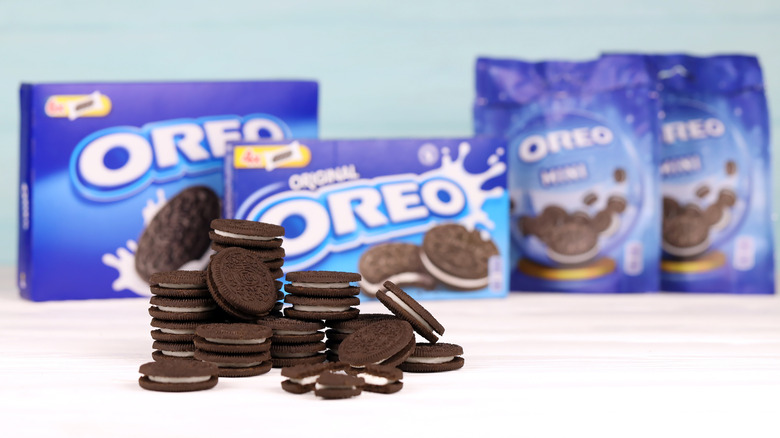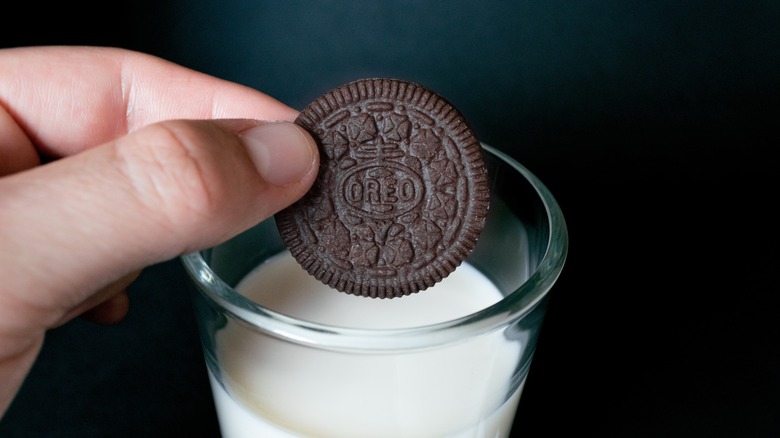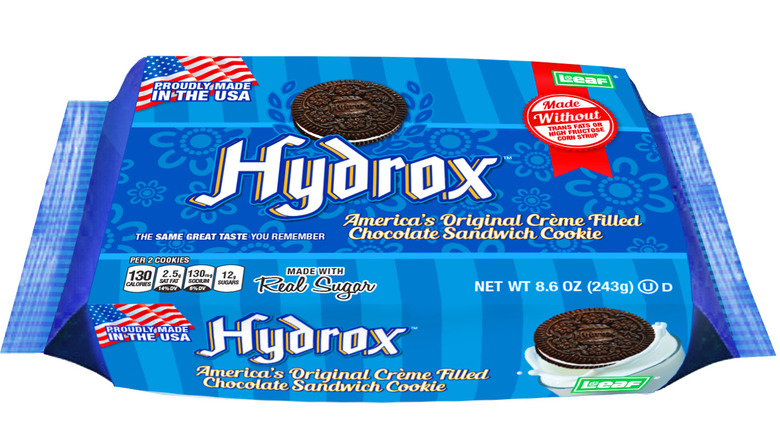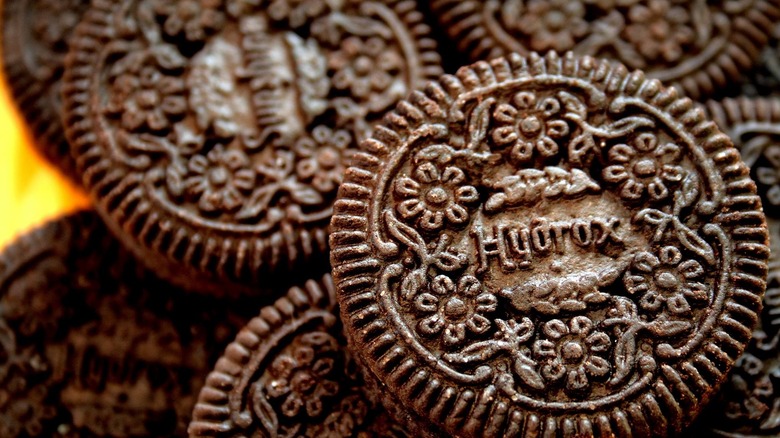The First Creme Sandwich Cookies Came Years Before Oreo
Ask an American to name the first-ever creme-filled sandwich cookie, and the answer will almost certainly be the Oreo. The iconic black and white cookie has become as definitively associated with its category as Xerox has with copiers, or Google with search engines. Ironically, however, the Oreo wasn't the first creme-filled sandwich cookie, and the cookie brand that beat it to the punch is still around.
That's not to say the Oreo doesn't have a long history, of course. It has been sold for more than 100 years, and has been wildly popular since 1912, when Nabisco first created the product in New York City. In fact, from the first Oreos sold at a Hoboken grocery store in 1912 to 2011 — on the eve of the cookie's 100th anniversary — more than 500 billion of them were sold around the world.
Sales weren't quite so brisk for the Hydrox cookie, despite the fact that it looks almost exactly like the Oreo — wafer-like black cookies sandwiching a white creme filling — and was actually created four years earlier in 1908. Timing isn't everything, it turns out. Naming and marketing are also pretty important factors when it comes to long-term success.
How Oreos became the ubiquitous creme-filled cookie
Oreos didn't immediately crush Hydrox cookies upon their debut in 1912. Perhaps that's because back then they were known as Oreo biscuits. Oreo works just fine as a name — reportedly, the name came from their golden packaging ("or" is French for gold) — but Oreo Biscuits doesn't have quite the same ring as Oreo chocolate sandwich cookies, the descriptor Nabisco eventually settled on.
So when and why did Oreos become more popular than Hydrox? The truth of the matter is that Oreos outpaced its rival not just with a superior name, but with superior marketing. The patented Oreo twist was launched as a marketing idea in 1923, and in subsequent decades, Nabisco would also tailor marketing to female consumers and noticeably improve the product's packaging. By the time Nabisco's "Oh, oh, Oreo" slogan was unveiled in the 1950s, the creme-filled upstart had not only completely taken over the category, but become one of the most popular cookies in the U.S.
Oreo's global dominance, however, was still to come. Again, marketing was the deciding factor. Although originally founded by Nabisco, Oreos were acquired by Mondelēz (formerly Kraft Foods) in 2000. After the iconic cookies were introduced to China to lukewarm sales in 1996, Kraft modified their appearance and recipe to suit regional preferences. It worked, and Kraft followed the same strategy when it introduced the cookies in India and elsewhere. As a result, Oreos are now available in over 100 countries worldwide.
Why Hydrox cookies never had a chance against Oreos
Sunshine Biscuits is a good name for a company. That's who came up with the original creme-filled cookie in 1908. Unfortunately, the name they decided on for their new product wasn't quite as catchy. Hydrox is kind of clever in that it's a portmanteau word combining hydrogen and oxygen, the two elements that comprise water. But it's not so clever in that it has nothing to do with cookies, and sounds a little too chemical for most people's tastes.
The name alone probably accounts for how badly upstart Oreo trounced Hydrox when it came to sales. By 1998, two years after Keebler bought Hydrox cookies from Sunshine Biscuits, it was estimated that the original creme-filled sandwich cookies had brought in $16 million in sales. Not terrible, but a far cry from the $374 million in sales Oreo managed during that same year.
Keebler, an iconic brand with a history of making cookies since 1853, certainly understood the nature of the problem. That's why in 1999, they finally changed the name of Hydrox cookies. Sadly, however, they too failed to find a name which did justice to the historic cookie, which had forever defined a new genre in the American snack aisle. After considering names like Choco Twists, Hydihos, and Twisters, they decided instead to go with Droxies. It was less chemical, but still sounded more like a pharmaceutical product than a cookie.
Hydrox fails, then finally succeeds
Not surprisingly, Droxies failed as a rebranding effort. Kellogg's bought Keebler in 2001, and stopped making Droxies two years later. But the long, strange history of the first creme-filled sandwich cookie wasn't over. Ellia Kassoff's Leaf Brands brought Hydrox cookies back to snack aisles in 2015, with the original name and formulation. Simply by surviving as a product since 1908, Hydrox cookies have become an enduring success story.
Kassoff didn't just bring Hydrox back from the dead; he also revived the long-time rivalry with Oreos. No, Hydrox will probably never have sales comparable to Oreo, which is reportedly the best-selling cookie around the globe. But it has joined the battle again by pointing out on its packaging some of the differences with its more famous competitor. Hydrox cookies are made in the U.S., for example, while many Oreos are now produced in Monterrey, Mexico, where Mondelēz — Oreo's parent company — maintains two large facilities capable of manufacturing millions of cookies per day for popular brands like Chips Ahoy! and Oreos.
Hydrox has also lodged two complaints against Mondelēz with the Federal Trade Commission, in 2018 and 2021, alleging that the owner of its more successful imitator, Oreos, is trying to make its products more difficult to find on supermarket shelves. Mondelēz has stated that the complaints are baseless, but one thing seems abundantly clear: Over 100 years after Hydrox and Oreo premiered their similar looking cookies, the brands are still competing.




